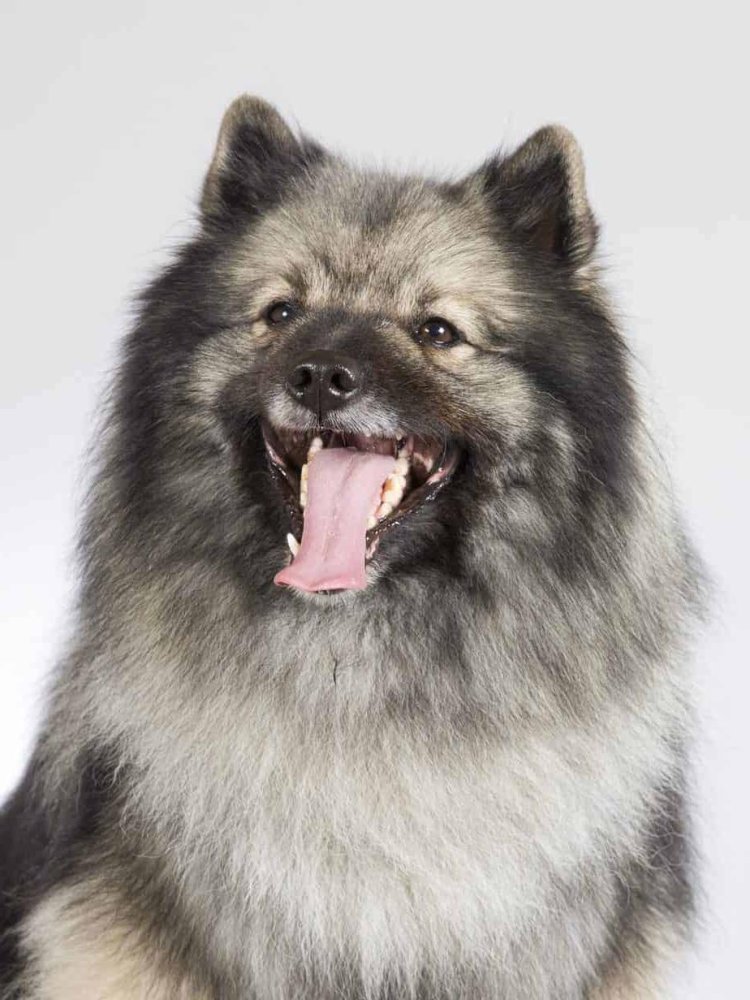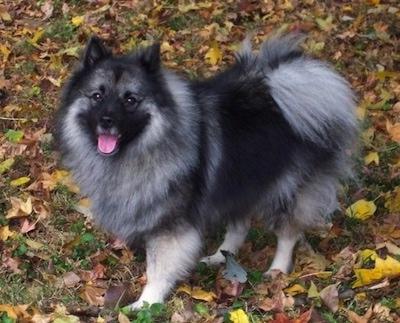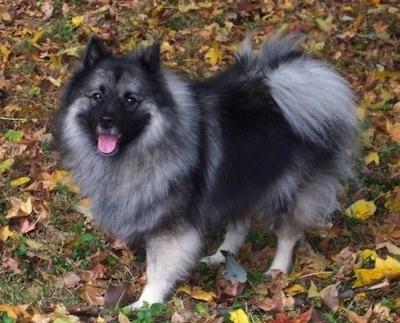- Breed Category: Companion dog
- Country of Origin: Netherlands
- Average Height: Males 45 cm, Females 43 cm
- Average Weight: Males 20 kg, Females 18 kg
- Average Life Span: 12 to 15 years
- Grooming Requirements: Weekly brushing needed
- Exercise Requirements: Moderate daily exercise
- Coat Type: Double coat, thick and plush
- Coat Color Variations: Grey, black, and cream
- Shedding Level: High shedding
- Ear Type: Erect, triangular ears
- Tail Type: Curled over the back
- Temperament: Friendly, alert, and playful
- Intelligence Level: Highly intelligent
- Barking Tendency: Moderate to high
- Compatibility with Children: Very good with children
- Compatibility with Other Pets: Generally good with other pets
- Training Ease: Relatively easy to train
- Common Health Issues: Hip dysplasia, heart issues
- Dietary Needs: Balanced diet, avoid overfeeding
- Energy Level: Moderate energy level
- Drooling Tendency: Low drooling tendency
- Sensitivity to Weather: Sensitive to heat
- Overall Maintenance Level: Moderate maintenance
- Original Purpose: Barge dog, watchdog
- Year of Recognition by Kennel Clubs: 1930
- Apartment Friendly: Yes, with sufficient exercise
- Best Suited For: Families, active individuals
- Cost of Ownership: Moderate
- Unique Traits: Spectacles-like facial markings
- Cultural Significance: Symbol of Dutch patriotism
- Popularity Rank: Moderately popular
Imagine a dog that’s not just a pet but a lively companion with a rich history and a heart full of loyalty. Meet the Keeshond, a breed that’s as charming as it is intelligent. Known for their distinctive “spectacles” around their eyes and a plush, silver-grey coat, Keeshonds are more than just a pretty face. They’ve been around for centuries, originally serving as watchdogs on Dutch barges. Today, they’re beloved family dogs, known for their friendly nature and adaptability. This article will delve into the unique characteristics of the Keeshond, explore their fascinating history, and provide insights into their care. Whether you’re considering adding one to your family or just curious, you’ll find everything you need to know.
History and Origin

Early Development of the Breed
The Keeshond has roots that stretch back to the 18th century in the Netherlands. Originally bred as a barge dog, they were the trusty companions of Dutch sailors and tradesmen. Their role was to guard the barges and alert their owners to any potential threats. This early development shaped the Keeshond into a vigilant and loyal breed, traits that are still evident today.
Role in Dutch History and as a Companion Dog
In Dutch history, the Keeshond became a symbol of the Patriot faction during a time of political unrest. They were named after Cornelis (Kees) de Gyselaer, a leader of the Dutch Patriots. This association with a political movement gave the breed a unique place in history. Over time, as the political climate changed, the Keeshond transitioned from a symbol of rebellion to a beloved family companion, known for their friendly and affectionate nature.
Key Historical Figures and Events
One of the most notable figures associated with the Keeshond is Cornelis de Gyselaer, whose leadership during the Dutch Patriot movement helped cement the breed’s place in history. The Keeshond’s popularity waned after the Patriots’ defeat, but their charm and companionship eventually won over dog lovers worldwide, leading to a resurgence in their popularity as a family pet.
Physical Characteristics

Appearance
The Keeshond is a medium-sized dog, typically weighing between 16 to 20 kilograms. Their coat is a striking feature, with a thick, double-layered fur that’s predominantly silver-grey with black tips. This gives them a distinctive, almost wolf-like appearance. Around their eyes, they have unique “spectacles” – dark markings that add to their expressive look. Their ears are small and pointed, standing erect, which complements their alert expression.
Unique Physical Traits
One of the standout traits of the Keeshond is their fox-like expression, which is both endearing and intelligent. Their tail is another notable feature, plumed and carried over their back in a graceful curve. This tail, combined with their fluffy coat, gives them a regal appearance. Despite their elegant look, they’re sturdy and well-built, ready for both play and work. These physical traits not only make them visually appealing but also contribute to their role as a lively and engaging companion.
Temperament and Behaviour

Typical Personality Traits
Keeshonds are known for their loyalty and intelligence, making them a joy to have around. They’re quick learners and eager to please, which makes training a breeze. Their sociable nature means they thrive on interaction, whether it’s with family members or visitors. They’re not just smart; they’re also incredibly affectionate, often forming strong bonds with their human companions.
Suitability as a Family Pet and Companion
If you’re looking for a family-friendly dog, the Keeshond is a top contender. They’re adaptable and can fit into various living situations, from apartments to larger homes. Their friendly disposition makes them excellent companions for families of all sizes. They’re not overly demanding but do appreciate regular attention and playtime.
Interaction with Children and Other Animals
Keeshonds are generally great with kids, known for their gentle and playful nature. They’re patient and can handle the energy of young children, making them ideal playmates. When it comes to other animals, they’re usually sociable and can get along well with other pets, especially if introduced properly. Their friendly demeanour ensures they’re a harmonious addition to any household.
Training and Exercise Needs

Importance of Early Training and Socialisation
Getting a head start on training and socialisation is crucial for a Keeshond. These dogs are naturally intelligent and eager to learn, so introducing them to various environments, people, and other animals early on helps them grow into well-rounded adults. Early exposure reduces the risk of behavioural issues and ensures they’re comfortable in different situations.
Recommended Training Techniques
Positive reinforcement is the way to go with Keeshonds. They respond well to praise, treats, and play, making training sessions enjoyable for both of you. Consistency is key, so keep commands clear and sessions regular. Avoid harsh methods, as these can lead to fear or anxiety, which is counterproductive for such a sensitive breed.
Daily Exercise Requirements and Activities They Enjoy
Keeshonds are active dogs that need daily exercise to stay happy and healthy. A couple of walks a day, combined with some playtime, usually does the trick. They love activities that engage their minds, like puzzle toys or agility training. These not only keep them fit but also mentally stimulated, which is just as important.
Health and Lifespan

Common Health Issues
Keeshonds are generally healthy, but like any breed, they can be prone to certain health issues. Some of the common concerns include hip dysplasia, patellar luxation, and heart conditions. Regular vet check-ups are essential to catch any potential problems early. Keeping an eye on their weight is also crucial, as obesity can exacerbate joint issues.
Average Lifespan and Tips for Keeping Them Healthy
With proper care, Keeshonds typically live between 12 to 15 years. To ensure they enjoy a long, healthy life, provide a balanced diet and regular exercise. Mental stimulation is just as important, so engage them with interactive toys and training sessions. Regular grooming is also key, as their thick coat can hide skin issues if not properly maintained.
Preventative Care Recommendations
- Schedule regular veterinary check-ups to monitor their overall health.
- Maintain a healthy diet to prevent obesity and related health issues.
- Ensure they get daily exercise to keep their joints and muscles strong.
- Brush their coat regularly to prevent matting and skin problems.
- Keep up with vaccinations and parasite control to protect against common diseases.
Grooming and Maintenance

Coat Care and Grooming Routines
The Keeshond’s coat is a standout feature, but it does require regular attention. Their double-layered fur needs brushing at least twice a week to prevent matting and tangles. A slicker brush and a metal comb are your best friends here. Regular grooming not only keeps their coat looking its best but also helps reduce shedding around the house.
Shedding and Seasonal Grooming Tips
Keeshonds are known to shed, especially during seasonal changes. During these times, daily brushing can help manage the extra fur. A good bath every few months will also help keep their coat clean and healthy. Just make sure to dry them thoroughly to avoid any skin issues. Regular grooming sessions are a great opportunity to check for any skin problems or parasites.
Diet and Nutrition
Nutritional Needs for Optimal Health
Feeding your Keeshond the right diet is crucial for their health and happiness. They need a balanced mix of proteins, fats, and carbohydrates, along with essential vitamins and minerals. High-quality commercial dog food often meets these needs, but always check the label for a good balance of nutrients. Fresh water should be available at all times to keep them hydrated.
Foods to Include and Avoid
Include lean meats, fish, and vegetables in their diet for a healthy mix. Avoid foods high in fat and sugar, as these can lead to obesity and other health issues. Steer clear of chocolate, grapes, and onions, as these are toxic to dogs. Treats are fine in moderation, but they should never make up more than 10% of their daily intake.
Feeding Schedules and Portion Recommendations
Establishing a regular feeding schedule helps maintain their digestive health. Typically, two meals a day—morning and evening—work well for adult Keeshonds. Puppies may need more frequent meals. Portion sizes depend on their age, weight, and activity level, so consult your vet for tailored advice. Keep an eye on their weight and adjust portions as needed to prevent obesity.
Fun Facts and Trivia

Interesting Tidbits About the Breed
The Keeshond is often referred to as the “Smiling Dutchman” due to their cheerful expression and friendly nature. They have a unique ability to “talk” by using a range of vocalisations, from barks to howls, which makes them quite the conversationalists. Despite their fluffy appearance, Keeshonds are surprisingly low-maintenance when it comes to exercise, making them perfect for both active and more relaxed households.
Famous Keeshonds in Media or History
One of the most famous Keeshonds in history is “Trixie,” who belonged to the renowned author Dean Koontz. Trixie was not only a beloved pet but also inspired several of Koontz’s books. In the world of television, a Keeshond named “Keesha” appeared in the popular series “Full House,” charming audiences with her playful antics. These appearances highlight the breed’s appeal and versatility, both as companions and as stars in their own right.
Final Thoughts
The Keeshond is a delightful blend of charm and intelligence. This breed’s rich history and friendly nature make it a beloved companion for families and individuals alike. While they require regular grooming and moderate exercise, the rewards of their loyalty and affection are immeasurable. Embracing a Keeshond means welcoming a piece of Dutch heritage and a loving friend into your home. Consider adding this spirited breed to your family and experience the joy they bring.
